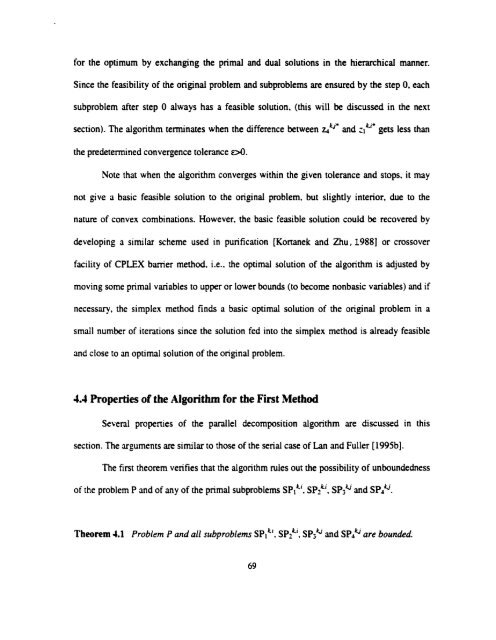X - UWSpace - University of Waterloo
X - UWSpace - University of Waterloo
X - UWSpace - University of Waterloo
You also want an ePaper? Increase the reach of your titles
YUMPU automatically turns print PDFs into web optimized ePapers that Google loves.
for the optimum by exchanging the prima1 and dual solutions in the hierarchicai manner.<br />
Since the feasibility <strong>of</strong> the original problem and subprobiems are ensund by the step O. each<br />
subproblem after step O always has a feasible solution. (this will be discussed in the next<br />
kl*<br />
section). The algorithm terminates when the difference between ab' and ci gets less than<br />
the predetermined convergence tolerance d.<br />
Note that when the algorithm converges within the given tolerance and stops. it may<br />
not give a basic feasible solution to the original problem. but slightly interior, due to the<br />
nature <strong>of</strong> convex combinations. However. the basic feasible solution could be recovered by<br />
developing a sirnilar scheme used in purification (Konanek and Zhu, 19881 or crossover<br />
facility <strong>of</strong> CPLEX barrier method, i.e.. the optimai solution <strong>of</strong> the algorithm is adjusted by<br />
moving some prima1 variables to upper or Iower bounds (to become nonbasic variables) and if<br />
necessuy. the simplex method fin& a basic optimal solution <strong>of</strong> the original problem in a<br />
small number <strong>of</strong> itentions since the solution fed into the simplex method is already feasible<br />
and close to an optimal solution <strong>of</strong> the original problem.<br />
4.4 Properties <strong>of</strong> the Algorithm for the Fint Method<br />
Sevenl properties <strong>of</strong> the parailel decomposition algorithm are discussed in this<br />
section. The arguments are sirnilar to those <strong>of</strong> the serial case <strong>of</strong> Lan and Fuller [1995b].<br />
The fint theorem verifies that the algorithm mies out the possibility <strong>of</strong> unboundedness<br />
<strong>of</strong> the problem P and <strong>of</strong> any <strong>of</strong> the prima1 subproblems spit', SP?', sPjb and SPI?<br />
Theorem 4.1 Prublern P and al2 subprublem SP~''. SP?'. SP;' and SP~' are bounded
















